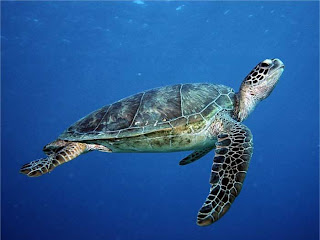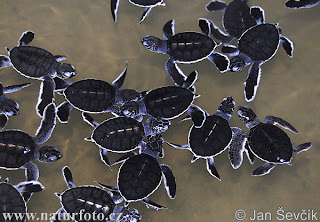Common Name: Green turtle; Tortue comestible, tortue franche, tortue verte (Fr); Tortuga blanca, tortuga verde (Sp)
Scientific Name: Chelonia mydas
Population: Approx. 203,000 nesting females
This big, thoroughly aquatic turtle seldom comes to land except to bask and sleep and to lay eggs . Males have slimly longer, narrower shells than females and enlarged curved claws on the front flippers for grappling the female when mating . Green turtles are mainly herbivorous creatures and have serrated jaw surfaces, considerably suited to feeding on sea grasses and seaweed ; some crustaceans and jellyfish may also be eaten .
Scope of Green TurtleThe best feeding lands, where there are immense submerged pastures of plants , are often far away from the best nesting beaches, and green turtles have evolved astounding migratory habits . At nesting time they locomote hundreds of sea miles to the beach of their birth to lay eggs, and as a result, there tend to be a limited number of significant nesting sites , to which hundreds of turtles go. One such site is Ascension Island in the mid atlantic . Every second or third year, green turtles travel to their nesting site and mate . The female heaves herself up the beach well away from the tidal area . With her foreflippers she sweeps away sand to create a hollow to lie in, her shell flush with the beach. She then utilizes her hind flippers to dig a hole about 40 cm (16 in) deep , immediately beneath her tail. She deposits her eggs into the hole, covers the area with sand and returns to the sea. The average grip contains about 106 eggs. Sometimes a female lays several clutches in a season at 2-week intervals. After a 2 - to 3-month incubation period, the young turtles hatch and dig their way through the sand to the surface. Having oriented themselves, they rush for the sea, past a horde of eager predators. Deathrate is high, and those which do reach the sea will have to face so far more predators.
The green turtle is now an endangered species, and the population has been eliminated in some areas , although it is still reasonable in others. The turtles have been overexploited for their meat, hides and eggs, and the predictability of their nesting habits has created them easy dupes. Exploitation is now strictly mastered, and imports are banned in many countries. The closely related flatback turtle, C. depressa, is a little smaller than the green turtle and inhabits off the sea coast of Northern Australia.
Previous Post : Polar Bear


No comments:
Post a Comment